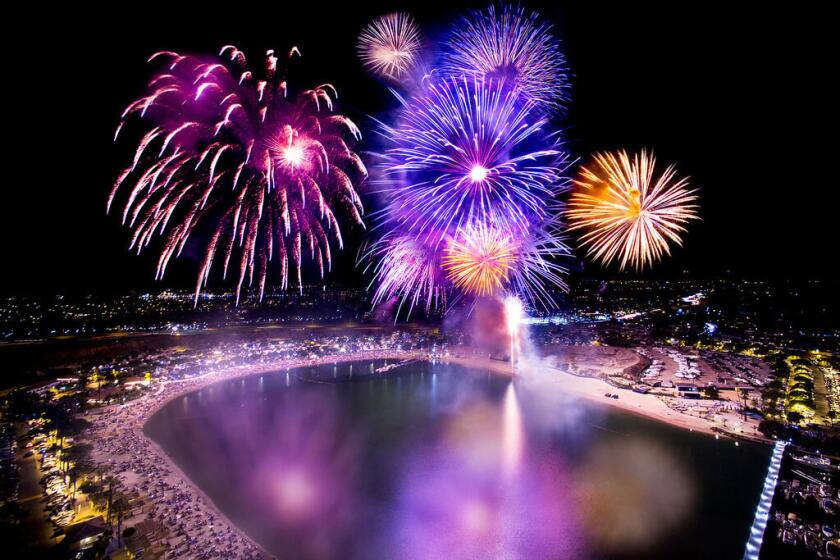Vistas of the past
- Share via
The Irvine Museum is known for its splendid collection of California landscapes and a selection of its paintings is now being shown at Laguna College of Art & Design in a wide-ranging exhibit, “Masterpieces from Irvine Museum,” that has a surprisingly historic aspect.
The Irvine Museum, founded in 1992 by Laguna resident Joan Irvine Smith and her late mother, Athalie R. Clarke, is “the only museum in California dedicated to the preservation and display of California Impressionism or Plein-Air paintings, an art style that flourished in California from 1890 to 1930,” according to the museum’s website.
Plein-Air painting flourished during the years when California was being discovered and developed, and painting the natural beauty of the state was especially embraced by those artists who called themselves Impressionists, according to Dora James, the Irvine Museum’s curator of education.
“Impressionism started in France in the 1860s and came to California in the 1890s,” James said. “Artists came here from Chicago and the Midwest because the light of California was similar to the light in the south of France.”
But unlike the French Impressionists, who focused their artistic gaze primarily on urban scenes, society life and manicured parks, the California Impressionists were drawn to the wild landscapes, the ocean, mountains and deserts that make up the “golden state.”
The exhibit at Laguna College, also called “El Camino de Oro: Journey through Early California,” takes the viewer back to the pristine views of some of the state’s most treasured spots, including Yosemite, and an exquisitely beautiful spot near Yosemite that is now deep under the Hetch Hetchy Reservoir.
James has a treasure trove of fascinating facts and interesting trivia about early California and the artists who flocked here, many to Laguna Beach, which was originally conceived as an art colony.
In the early years, the Santa Fe Railroad would allow the artists to ride for free, and even eat for free in the railroad stations, she said. In return, the painters provided original “posters,” wonderful oil paintings that the railroad used in its stations all around the country, to advertise the wonders of the west and promote tourism by rail.
The Mission at San Juan Capistrano became a favorite subject of the painters, especially since it was near a railroad stop, she noted.
The exhibit takes the viewer through the varied facets of California’s early natural beauty, from the desert to the sea.
Paintings range from Frank Cuprien’s misty and Turneresque “The Dream Ship,” to several sunny scenes of Mission San Juan Capistrano. One 1918 painting of the mission is by William Wendt, one of the founders of the Laguna Beach Art Assn., which evolved into the Laguna Art Museum.
An exquisitely beautiful Laguna work is “Moonlight, Laguna Beach” by William Lees Judson, who was also part of the early art colony in Laguna, according to James.
Granville Redmon’s “Evening,” painted in 1910, is another magnificently moody work that contrasts with the sun-splashed landscapes.
One of the earliest paintings in the exhibit is an 1896 work by Thaddeus Welch, “Marin County, Bolinas Bay,” from the rancho period, a detailed country scene of cattle and ranch workers in the San Francisco Bay Area.
A very large painting by James Swinnerton depicts the Monument Valley in Utah, one of the places the imported Impressionists would have traveled through on their way to the Golden State. The painting shows the dramatic rock formations in the background as a campfire burns in the foreground, and sparks fly up into the night.
“Yosemite Falls from the Valley” by Maurice Brown is an early rendering of an iconic spot, along with “Redwoods” by Harrycassie Best, who became the father-in-law of iconic nature photographer Ansel Adams, according to James. Best invites the viewer to step into the woods with a delicate interplay of dark and light.
Some of the artists put themselves into their paintings, to show the scale of the magnificent scenery around them, James said. All the paintings bring the viewer into the scenery and the mood of the moment with expert use of color.
One of James’ favorite works is a nocturne, or night painting, of the Ventura Mission, Buenaventura, painted in 1928 by Vernon Jay Morse, yet another member of the Laguna Beach Art Assn. — and another example of how embedded Laguna Beach was in the California Impressionist movement.
The show will be at the college’s Ettinger Gallery, 2222 Laguna Canyon Road, through Sept. 26. The gallery is open 9 a.m. to 5 p.m. Monday through Friday, and Saturday from 9 a.m. to 4 p.m. Admission and parking are free.
A reception for the show will take place from 6 to 9 p.m. Thursday, during First Thursdays Art Walk.
For more information about the Irvine Museum, visit https://www.irvinemuseum.org.
All the latest on Orange County from Orange County.
Get our free TimesOC newsletter.
You may occasionally receive promotional content from the Daily Pilot.





